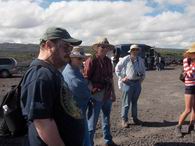
|
The lava hiking group: Carolyn, Mark, Martin and Shawn Ratcliffe (right of Mark), David Eicher of Astronomy Magazine, Govert Schilling and his daughter Mara (from the Netherlands), and Steve O'Meara (bending over in the foreground). At least most of us were geared up for hot conditions with lots of water, long pants and rugged shirts (if you trip on the lava you can cut yourself up pretty badly), food and snacks. The plan was to hike out to find "first contact" with the lava flows, and then head to the coast to watch lava flowing into the sea.
|
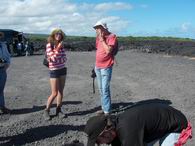
|
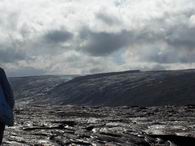
|
We entered the field from the Kalapana Gardens side. This area has been under fairly constant attack from the volcano since the 1990s. Carolyn first visited here in 1990, when Kalapana Gardens was being evacuated. Everything you see here was once a rain forest with homes hidden in the trees. The smoke in the distance on the lava cliff (the pali) is where the flow comes down from the Pu'u O'o vent (pronounced POO-ooh OH-oh) on Kileaua.
We skirted around lava that was flowing quite actively, heating the air over the ground to well above 100º F. The flow in the foreground is called pahoehoe, a soft, elastic, ropy kind of lava that resembles hot flowing peanut butter in composition. It's about 1200º F as it flows. It cools very quickly, and within about 10 minutes or so you can walk across it, provided you have good, thick-soled boots and the lava is thick.
|
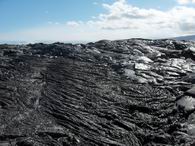
|
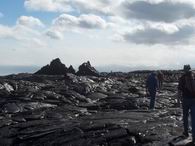
|
When lava flows, it covers everything. If there's vegetation underneath, it rots in the heat. This causes gases to build up. Lava also has gas in it, which is why flows can be dangerous places if there's too much gas buildup. You could suffocate.
When the gases from the underlying rot and the rocks combine, they push upward on the layers of lava. Since lava is very brittle and glass-like, it swells into a bump called a tumulus. Eventually, if there's enough pressure from the gas buildup, the tumulus bursts open, sending rock flying across the landscape. We approached a large, broken tumulus about a half-mile into our hike.
|
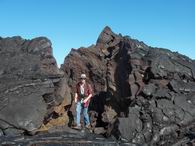
|
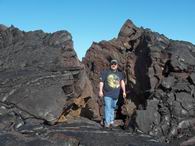
|
Mark also checked out the tumulus, which covered a few tens of yards in diameter and towered up about 15-20 feet in places. When this one blew it must have been a tremendous explosion.
One of the most fascinating things about lava flows is that they don't stay sterile and dead for long. Within a few days or weeks, ferns and other small plants start growing wherever they can.
|
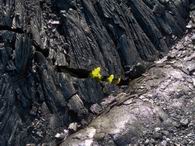
|
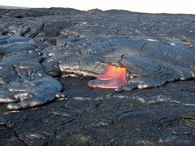
|
About an hour into our hike we made first contact with flowing lava, a pahoehoe "toe" flowing from a crack in older rock. The "toe" is about a two feet wide at this point, and is flowing at a rate of a few inches per second—a leisurely rate, but an inexorable one.
Of course we all ventured close to get a picture taken with the flow. Within a few minutes the area where we were standing was engulfed in lava.
|
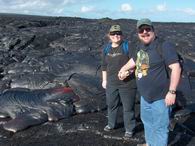
|
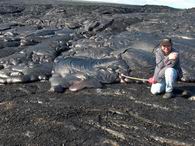
|
Steve O'Meara brought along a bag of marshmallows and he roasted a few for us. It didn't even take 30 seconds to roast one black; the lava was that hot!
We ambled along toward some other lava flows, including one a few yards away that was rapidly filling in a small valley that had been created maybe a day or so earlier. Mark pointed out how fast it was moving.
|
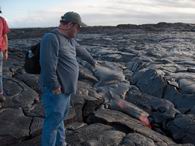
|
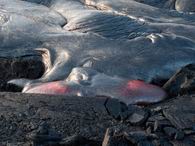
|
This image was taken within a few feet of the lava flow.
As soon as we finished our closeups, we wandered over to yet another flow that was overtaking lava deposits that had probably been laid down earlier in the day. The rock under our feet was just touchable, but very warm. The smoke in the distance is rising up from other fields of freshly flowing lava about a half-mile or so away.
|
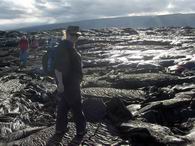
|
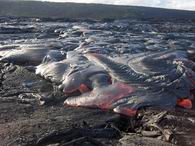
|
The lava kept coming, slowly but surely, flowing over rock laid down not more than a day or so earlier. And, just as it flowed, it cooled and hardened. Then, another molten finger would burst out. At one point somebody said that we were watching the last steps in the death of a massive star. If you think about it, that's correct; and we were watching the NEWEST steps in the creation of our planet.
At one point we crossed over a tumulus flow, lava that was bursting out of the jaws of a tumulus that had blown open. The flow was about 20 feet wide and moving quite a bit faster than the slower flows we'd been playing with up to that time. We hustled across as quickly as we could.
|
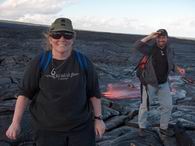
|
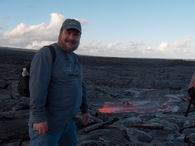
|
Mark also took a moment to pose with Madame Pele's outflow before we all took off to the coast.
Eventually, we arrived at a cliff overlooking the lava tube entrance to the ocean. The cliff itself was quite warm, and probably had only been molten a few days or weeks before we got there. Nonetheless, it was a place to sit and have dinner and rest before hiking back to the parking area.
|
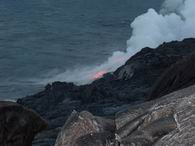
|
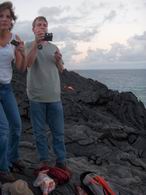
|
We stayed on the cliff for about an hour. We all took pictures (like Martin and Shawn are doing here) because the action of the lava flowing into the ocean was stunning.
Mark rested his rapidly blistering feet and sucked down some welcome water. On the cliff in back of him there are plumes of gas rising from still-molten lava under the crust.
|
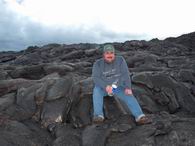
|
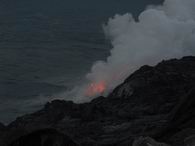
|
The lava flows into the ocean and is immediately cooled and blasted back up out of the water by the action of the waves. This sends shards of volcanic glass flying back toward the cliffs. We were probably 100 yards away (or a bit more) so were out of the direct line of fire. The cloud of steam is very acidic and dangerous, too.
|
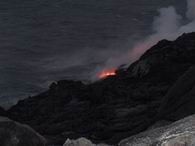
|
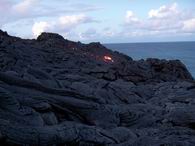
|
As it got dark we noticed glowing crevices in the rocks all around us. There was lava "down there" and it was still hot and red! We finally decided to head back, a trek that took us about an hour and a half to complete in darkness lit only by our flashlights and the light of a near-full Moon.
|
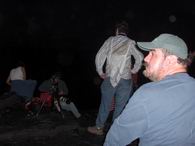
|